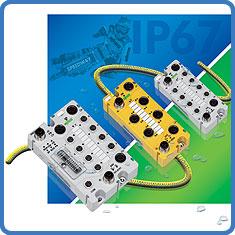
It began with an idea. Our basic thought was to find an alternative to the normal screw-type connection in the connecting technology field. From this idea we developed spring clamp terminal blocks.
WAGO underpinned its conviction that this was the method of the future with the founding of the company in 1951 and has not wavered from this course since then. This technology has long since become the worldwide standard and modern electrical connecting systems and automation without WAGO products is unimaginable.
Many people have contributed to the WAGO success story through their commitment and dedication. All of them believed in the potential of our company and were receptive for new ideas and processes and advanced these ideas with a sincere and passionate effort.
Speedway 767 - The New Performance Class


After 10 years of experience with IP 20 I/O modules, WAGO again achieves a milestone in automation technology, with a new performance class of IP 67 I/O modules. Consequently designed to the last detail, the sum total of the features creates a total system which is setting new boundaries in the marketplace.
The growing demand for automation without control cabinets is still limited by cumbersome, slow and inflexible I/O systems whose functionality is far behind that of modern IP 20 I/O systems.
WAGO is introducing a new series of IP 67 protected modular I/O modules called WAGO SPEEDWAY 767, which matches the latest IP 20 I/O products and opens up completely new possibilities.
Fieldbus Independent: In the first stage alone, the whole leading edge world of automation is opened up via PROFIBUS, PROFINET, ETHERNET IP and Device Net.
Modular: Up to 64 extension modules with 512 channels can be connected to the head station with integrated fieldbus connection. Machines may be extended up to a total extension of 500 meters.
Programmable: In addition to the fieldbus couplers, controllers for all fieldbuses are available with the standard CoDeSys IEC 61131 programming environment. CoDeSys version 3.0 guarantees the seamless connection to Automation Alliance.
Configurable: Combining different modules is a thing of the past: 0-10V, ± 10V, 0-20 mA, 4 – 20 mA, ± 20 mA input signals can be processed in a single input module, which is set channel wise. Many different functionalities can therefore be integrated into a single module. Threshold values, default values of different strategies, filter times can also be defined for each individual input. Start up is supported by the use of online simulation. Furthermore, operation modes like trigger mode or synchronous mode are available.
Diagnostics: Find instead of search! Significant diagnostic information is essential for distributed system architectures. WAGO-SPEEDWAY 767 provides for precise error localisation on station, module as well as channel level. This way, overload, short circuit, wire break and many other types of errors can be easily and quickly detected.
Data Quality: With Dynamic Speed Control (DSC), WAGO-SPEEDWAY 767 is the only I/O system capable of identifying the maximum possible clock frequency of a particular installation depending on its spatial extension. Data rates are therefore considerably higher than those of less flexible systems. Unmatched performance is achieved with cycle times lower than 100 µs and a jitter less than 1 µs even at maximum extension. Of course, the inputs and outputs of the whole system can be synchronised. Fast control loops can be closed reliably in drive applications and even the most demanding measurement applications can do without proprietary electronics. Hence, the potential of modern Ethernet-based fieldbuses can be fully exploited.
Safe: Safety technology based on IEC 61508 and standard automation have grown together for some good reasons. Both IP 20 and IP 67 systems meet the requirements of IEC 61508. This is why safety has been made an integral part of WAGO-SPEEDWAY 767, right from the beginning. SIL3 compliant safety I/O modules complement each PROFISAFE master. Therefore, the parallel operation of two automation systems is no longer required under IP67 conditions.
Ergonomically Designed and Accessible: Sensors and actuators can be connected using international standardised M8 and M12 connectors available world-wide. Servicing via USB interface makes modern PC technology accessible and offers a future-proof solution. Configuration is done via DTMs that can be seamlessly integrated into any FDT framework. Both marker strips and WMB Inline markers of the brand-new WAGO marking system demonstrate that a compact housing does not necessarily means poor handling and lack of marking. Large and easily identifiable marking can be simply and clearly assigned to each channel.
Robust: The modules are fully encapsulated, providing long-term sealing performance. IP 67 is intended for use in areas with splash water and often in harsh environmental conditions. WAGO-SPEEDWAY 767 is designed to operate in a range of temperatures from –25 °C to +60 °C. Furthermore, protection against EMC influence is provided by using a new shielding design. Functional safety in the field is provided by compliance with the WAGO EMC standard, which is far more stringent than the technically relevant standards.

